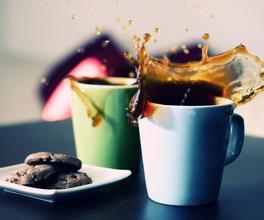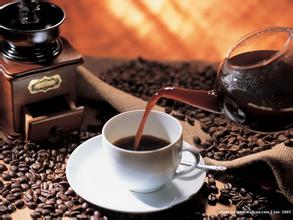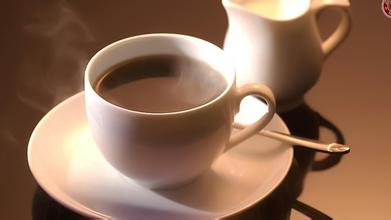Introduction to the brewing method of planting environment in the production process of Yunnan small-grain coffee beans
Yunnan Arabica Coffee Bean Production Process Planting Environment Brewing Method Taste Introduction
1)Purified water in moderation; use purified water from a household water fountain or filtered tap water.
2)Coffee beans/coffee powder;
Siphon pot cup of coffee water is 110 ml (but after boiling water will be reduced by about one-fifth), the corresponding coffee powder about 15 grams;
If conditions are available, it is best to use coffee beans within 10 days of the factory and grind them into coffee powder before brewing coffee;
The fineness of coffee powder can refer to the fineness of "extra fine" granulated sugar sold in the market.
3)A set of siphon coffee pot (here used is Hario TCA-3 type), including: upper cover, upper seat, lower seat, siphon pot holder, filter, alcohol lamp (using 95% industrial alcohol) and alcohol lamp windproof cover. Because it is difficult to adjust the firepower of the alcohol lamp during use, it is necessary to adjust it a little smaller (the cotton core only needs to leak slightly from the top 2 to 3 mm).
4) 1 teaspoon of 10 grams of coffee;
5)A bamboo stir stick;
6)A filter cloth or filter paper used in siphon pot; filter cloth should be blanched with hot water before first use to remove impurities.
7)a damp rag;
8)A clock of the hand type used for timing;
Specific brewing steps:
1)Add a proper amount of purified water to the bottom seat of the siphon pot (heated purified water can be used to shorten the boiling time. In this operation, the amount of water added is 2.5 cups, i.e. about 280 ml, two cups of water are for guests/friends, and the extra half cup is for the brewer to taste in advance. If you feel abnormal taste at that time, don't give it to the guests to drink, hehe);
2)When the fuel in the alcohol lamp is sufficient, ignite it and place it directly below the lower seat of the siphon pot;
3)Fix the filter covered with filter cloth/filter paper on the upper seat of the siphon pot, and ensure that the position of the filter is in the center (if the position is deviated, it can be adjusted with bamboo stirring rod);
4)Pour the right amount of coffee powder (2.5 cups of water corresponding to about 37 grams of coffee powder, can be adjusted according to personal taste) into the siphon pot seat. Shake the seat horizontally a few times to evenly coat the coffee powder on the filter;
5)Insert the upper seat of the siphon pot obliquely into the lower seat, but do not insert it tightly (if the upper seat is inserted after the water is boiled, the boiling hot water may suddenly spray out, which is quite dangerous, remember!);
6)After the water in the lower seat has completely boiled, temporarily remove the alcohol lamp for about 10 seconds and then move it back, but do not place it directly below the lower seat. It should be slightly offset from the center. This has two purposes: one is to reduce the water temperature to the most suitable temperature--95 degrees or so; the other is to reduce the firepower of the alcohol lamp (as mentioned earlier, the alcohol lamp is not very convenient in adjusting the firepower, which is also the reason why some people will rotate the use of two alcohol lamps or use gas stoves with adjustable firepower);
7)Centralize the upper seat and insert it into the lower seat (with a slight force);
8)At this time, the water in the lower seat increases in pressure due to heating, and flows into the upper seat along the riser of the upper seat. When the water in the lower seat is only 1/3 left, pour the ground coffee powder into the upper seat and pour the wet coffee powder from all sides to the middle with a bamboo stirring rod;
9)After the coffee powder is completely wet, start the timer (do not stir the coffee mixture at this time, this stage is called "stewing");
10)After about 45 seconds, quickly stir the coffee solution using a bamboo stir stick. Stirring can be stopped after a layer of foam appears on the surface of the liquid. Wait a few more seconds before the alcohol lamp is removed and extinguished.

Important Notice :
前街咖啡 FrontStreet Coffee has moved to new addredd:
FrontStreet Coffee Address: 315,Donghua East Road,GuangZhou
Tel:020 38364473
- Prev

Introduction to the taste of manor flavor description in Huilan producing area of Colombian coffee bean
Columbia coffee bean Huihuilan manor flavor description variety introduction while Quindo Cordillera is located in the central Colombian region, between the West Cottrella Mountains and the Central Cottrella Mountains in the Andes. The vast expanse here, the great Antioquia, with their modesty, diligence and continuous progress, toiled in the mountains.
- Next

Flavor description of Tarazhu Coffee beans in Costa Rica introduction of Grinding scale varieties in Manor production area
Costa Rican Tarazu Coffee Bean Flavor description the variety of grinding scale in Costa Rica is mostly washed, and in recent years there has been an alternative half-sun treatment (Miel) or (Honey Coffee), which can be translated as sweet as honey. Costa Rican coffee, which boasts that it is as sweet as honey, is Honey Coffee on the sack, which is quite robbed.
Related
- Detailed explanation of Jadeite planting Land in Panamanian Jadeite Manor introduction to the grading system of Jadeite competitive bidding, Red bid, Green bid and Rose Summer
- Story of Coffee planting in Brenka region of Costa Rica Stonehenge Manor anaerobic heavy honey treatment of flavor mouth
- What's on the barrel of Blue Mountain Coffee beans?
- Can American coffee also pull flowers? How to use hot American style to pull out a good-looking pattern?
- Can you make a cold extract with coffee beans? What is the right proportion for cold-extracted coffee formula?
- Indonesian PWN Gold Mandrine Coffee Origin Features Flavor How to Chong? Mandolin coffee is American.
- A brief introduction to the flavor characteristics of Brazilian yellow bourbon coffee beans
- What is the effect of different water quality on the flavor of cold-extracted coffee? What kind of water is best for brewing coffee?
- Why do you think of Rose Summer whenever you mention Panamanian coffee?
- Introduction to the characteristics of authentic blue mountain coffee bean producing areas? What is the CIB Coffee Authority in Jamaica?

